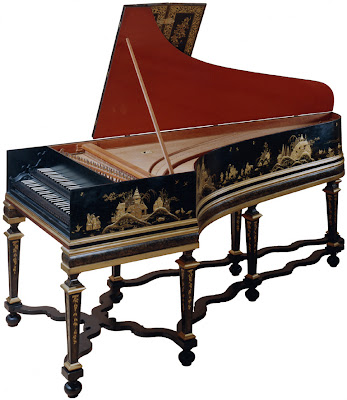
Its late afternoon and you're strolling through the twisting streets of the medieval hilltop town of Castelmuzio in Tuscany. You meander out along one of the country roads, where rows of tall cypress trees cast a pattern of long shadows across the gravel. A warm breeze dances over the dry brush and across your cheek. You hear music. The lilting notes of a keyboard. You stop for a moment and think maybe you're dreaming. You try to recall the number of glasses you had at the winery. You think perhaps the Italian tourism commission has hidden speakers in the clouds. But wait, there aren't any. The music persists. The source of this magic? The harpsichord workshop of Bruce Kennedy, below.

Originally located within the Chateau d’Oex-Gstaad, in the Swiss Alps, Kennedy's workshop has been the leading maker of harpsichords since 1985. His instruments are lauded not only for their unique sound, but for their sheer beauty.
Within a few short years, demand for the harpsichords had increased dramatically and, in need of a more practical working space, Kennedy relocated the workshop to Amsterdam, where it remained for 12 years. During that time, he produced more than 140 harpsichords and clavichords - essentially one a month - which have all found homes throughout the world. Kennedy's work can be found at the Juilliard School of Music, New York, the Sweelinck Conservatory, Amsterdam, the Cleveland Museum of Art, the Handel House Museum and the Guildhall School of Music in London, the Oslo Baroque Orchestra, the Centre de Musiques Anciennes in Geneva, Madrid's Royal Theater and music conservatories in Zurich, Prague and Vienna. They're the top choice for finalists performing in the Brugge International Harpsichord Competition and can be heard on hundreds of recordings.

German Harpsichord, 1702-1704, after M. Mietke (Berlin)
The Mietke is designed with a long brass scaling. With more than sixty made, its Kennedy’s most popular model. The square-baluster legs, serpentine stretchers and ball feet were typical of the period, but the black-and-gold Japanning would have been quite new and exciting. Japanning wouldn't reach its zenith for another few years.

Flemish Harpsichord, 1637, after A. Ruckers (Nuremburg)
The dark wood of this harpsichord's exterior, juxtaposed with the lightness and colorful scrollwork of the interior, was typical of the period. A similarly-decorated example was captured by Vermeer in the Music Lesson, circa 1662-64, below.

Royal Collection, St. James' Palace, London
After two decades of work, Kennedy decided to take a two-year sabbatical from instrument making and turned his artistic talents to the renovation of an old property in Tuscany, now home to the workshop.
Kennedy and his skilled artistans make a variety of models based on historic French, Flemish, German and Italian examples. Some are identical copies and some are loose interpretations, but their production is limited to just one at a time. Kennedy uses only those materials and methods that were used during the 17th and 18th centuries, including wooden jacks, string material reproduced based on original samples at Oxford University, and whenever possible (availability, not surprisingly, is limited), Swiss spruce soundboard wood from 1650-1775. Instruments are usually quilled in delrin, but may be bird quilled by request. Kennedy’s stable of artists, based in nearby Florence, can realize any decoration you dream up.

German Harpsichord, 1737, after C. Vater (Nurenburg)
Only a few copies of this harpsichord have been made. The one shown here replicates the original decorative design and barley-twist legs.

French Harpsichord, 1769, after P. Taskin (Edinburgh)
Kennedy’s Taskin is based on the famous original at St Cecilia’s Hall in Edinburgh, that was originally owned by the Taskin family until 1952. It is the epitome of Rococo style: cabriole legs and a scrolling apron, a soft blue and ivory palette, and lavishly decorated with romantic garlands of flowers.

Flemish Harpsichord, 1745, after J. Dulcken (Wingeshausen)
A strikingly modern example, with a geometric simplicity and turned legs on a narrow T-shaped base.
www.kennedyharpsichords.com
No comments:
Post a Comment